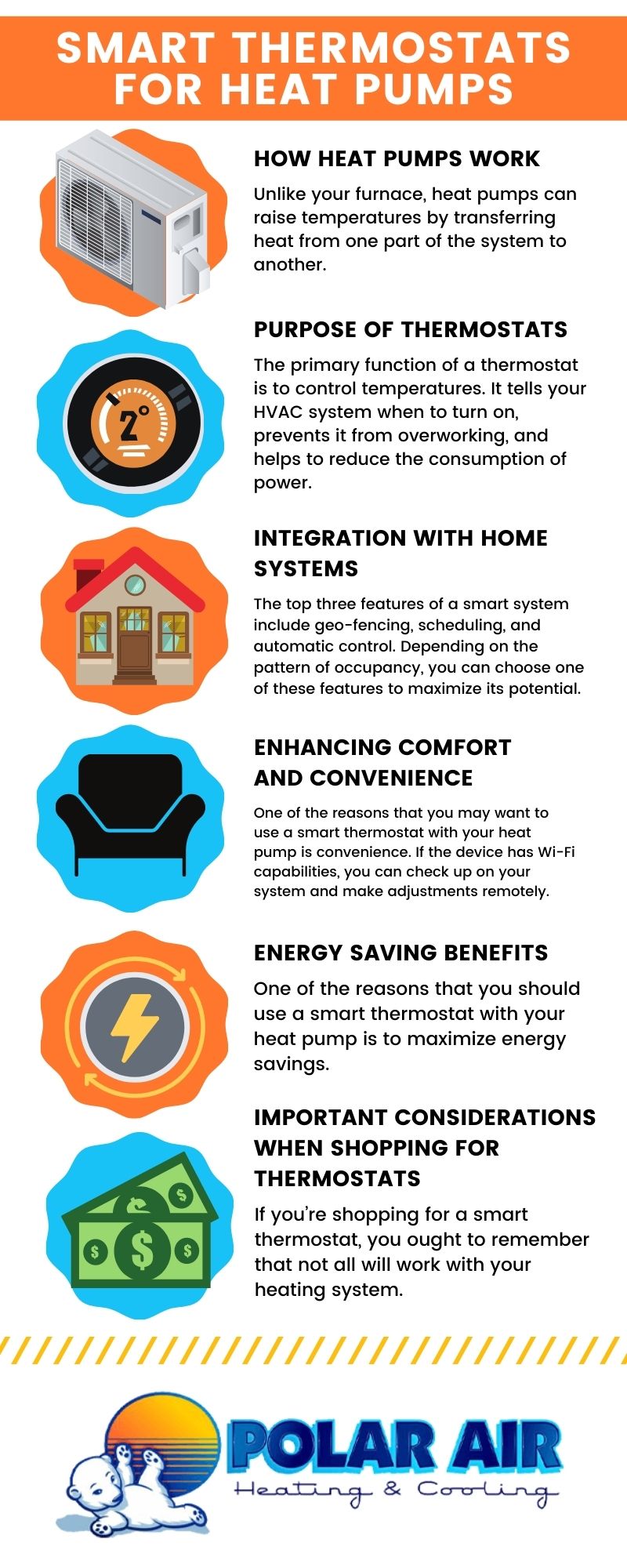Heating and cooling systems are becoming more efficient and convenient. You can use heat pumps for both and cooling and heating. A smart thermostat can boost your HVAC system’s operation and efficiency. Here are a few things that you ought to know about using heat pumps and thermostats.
How Heat Pumps Work
Unlike your furnace, heat pumps can raise temperatures by transferring heat from one part of the system to another. They extract energy by using a refrigerant to absorb heat from the outdoors and transferring it to the indoors. A compressor will force the refrigerant past two heat exchanger coils.
At low pressure, the refrigerant can absorb heat from the outdoors, even during cold weather. When compressed, it releases heat to the heat exchanger and turns to liquid. A heat pump can cool your home by simply reversing the process. As such, they can act as both air conditioners and heaters.
You can rely on a heat pump during both the cold and hot seasons. Even when temperatures are at -18 degrees Celcius, it can still extract 85% of the energy required for heating. It, therefore, cuts down the power consumption that you need to regulate temperatures.
Heat pumps primarily use the air outdoors to extract heat. However, there are heat pumps that use other sources, such as geothermal and geo-exchange. They operate on the same principle, but their suitability will depend on your location.
Types of Thermostats
The primary function of a thermostat is to control temperatures. It tells your HVAC system when to turn on, prevents it from overworking, and helps to reduce the consumption of power.
Thermostats fall into one of three major categories: mechanical, electrical, and smart devices. Mechanical devices are the most affordable and simple. You will only have to input the desired values, and the thermostat will regulate temperatures accordingly.
An electric system has more functionality than a mechanical device. You can change settings for the date and time and also choose between automatic and manual operation. It is ideal for homeowners who rarely use the house and want a device with a simple mechanism.
Smart thermostats come in a wide range of features to improve comfort, safety, and convenience. Depending on the devices, they can be programmable or Wi-Fi enabled. The type of device you choose will depend on how you use your home.
Integration with Home Systems
The top three features of a smart system include geo-fencing, scheduling, and automatic control. Depending on the pattern of occupancy, you can choose one of these features to maximize its potential.
If your pattern keeps changing from day to day, geo-fencing is often the best option. You can turn down your heat pump, and the thermostat will turn back on when you arrive. You won’t have to change the device settings; the thermostat will make the necessary updates automatically.
On the other hand, you can use scheduling if your schedule is predictable most of the time. You can adjust the settings so that temperature changes when you are using a given room. For example, it can heat the living room in the morning when you wake up. It is suitable for people who work from home most of the time.
The more recent models use machine learning to adapt to changes in your movements. They can record your daily routine automatically and make adjustments based on previous data.
Enhancing Comfort and Convenience
One of the reasons that you may want to use a smart thermostat with your heat pump is convenience. If the device has Wi-Fi capabilities, you can check up on your system and make adjustments remotely. You can use a mobile app or voice control to change settings whether you are in the bedroom or your office.
The latest models can also integrate with third-party home automation systems. A smart thermostat can work with Alexa, Google Nest, and Apple HomeKit. These devices are ideal for homes that already have a home system in place.
Heat pumps can also work with zoning systems to better regulate temperatures for optimal comfort. The thermostat can control dampers to heat only the room that is occupied. The configuration ensures that the temperature regulation in each zone is accomplished efficiently. Zoning can boost indoor air quality since it prevents contaminated air from getting to other parts of your home.
Energy Saving Benefits
One of the reasons that you should use a smart thermostat with your heat pump is to maximize energy savings. While a regular thermostat controls temperature, programmable devices have more features for more precise regulation. It ensures your heat pump is running only when necessary.
Smart thermostats leave little room for mistakes when you are adjusting the temperature of your home. They can use data that you had keyed in previously to make accurate predictions of your movement. Furthermore, they become more reliable the more often you use the device.
A smart system is easier to use, thanks to its numerous advanced features. With Wi-Fi and geo-fencing, you don’t have to be present for your system to adjust the settings. While on vacation, you may change the configurations when the weather changes when you are away.
Combining smart thermostats with heat pumps can yield considerable energy savings compared to other systems. Heat pumps do not require a lot of energy since they draw heat from their surroundings. According to a report by Nest, smart thermostats can reduce energy consumption by up to 12%. When you use both correctly, you can reduce your utility bills and increase your system’s lifespan.
Important Considerations When Shopping for Thermostats
If you’re shopping for a smart thermostat, you ought to remember that not all will work with your heating system. Some systems don’t work with low-voltage equipment such as older central air heating air conditioners. However, most of the latest models, such as Nest, can work with most systems.
Most devices can work with zoning systems, but you need to confirm their compatibility. You may require additional wires to connect to the system. Some systems may not work with the automatic dampers that control the heat pump and the different zones. It is wise to consider hiring a professional with an understanding of both zoning and smart thermostats.
Manufacturers of smart devices often provide compatibility tools that you can use to check if the heat pump is compatible. If you find a suitable thermostat, ensure that it is easy to adjust the settings. You may want one with a color LED screen with decent levels of usability.
You may also want to consider the device’s aesthetic features and location. Some devices are bulky and unappealing, which may influence where you place the thermostat. Keep the device away from direct sunlight or ambient heat from stoves and electronic appliances. The location of the thermostat can change the temperatures it records, making them ineffective.
You can always rely on Polar Air & Heating, Inc.‘s heating and cooling team in Las Vegas for dependable services. We install and repair furnaces, heat pumps, and central air conditioning systems. Our team can work with any model or brand of equipment, including Mitsubishi, Carrier, Honeywell, and Goodman.
If you are looking for exceptional customer experience and quality solutions, contact Polar Air & Heating, Inc. in Las Vegas today.





















